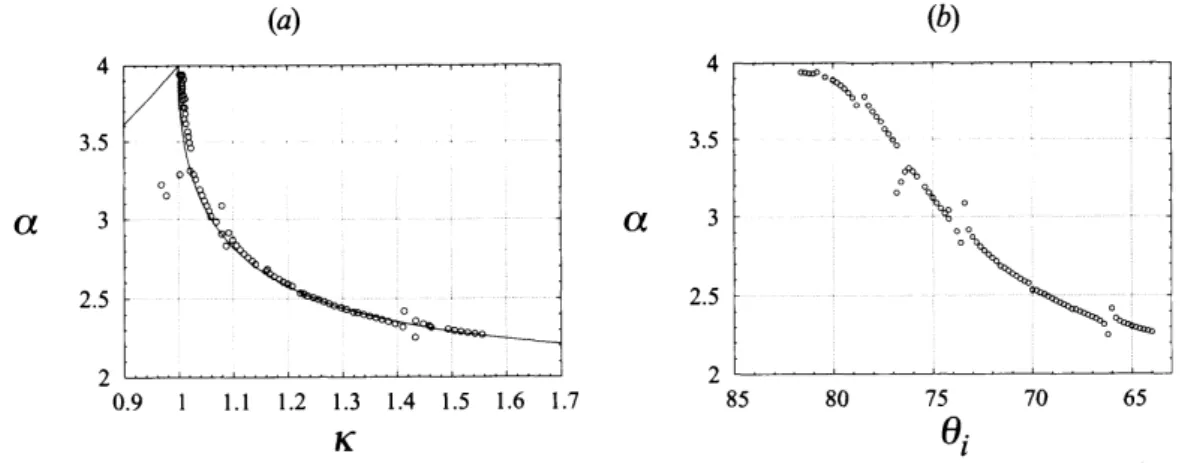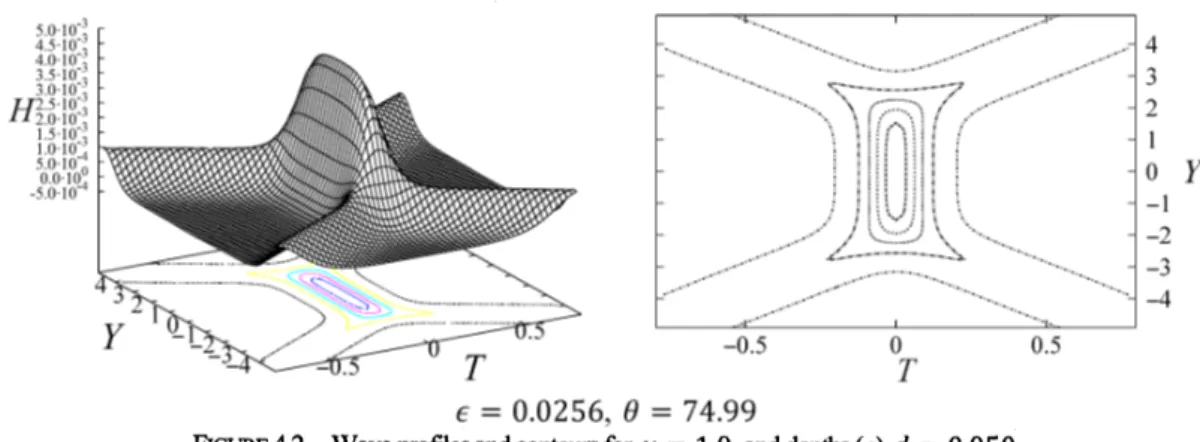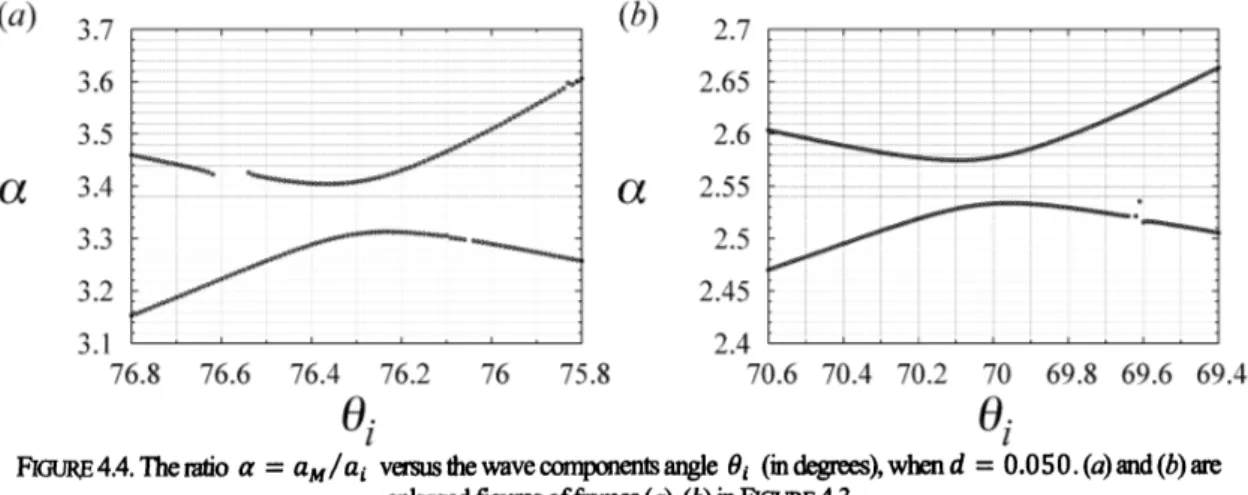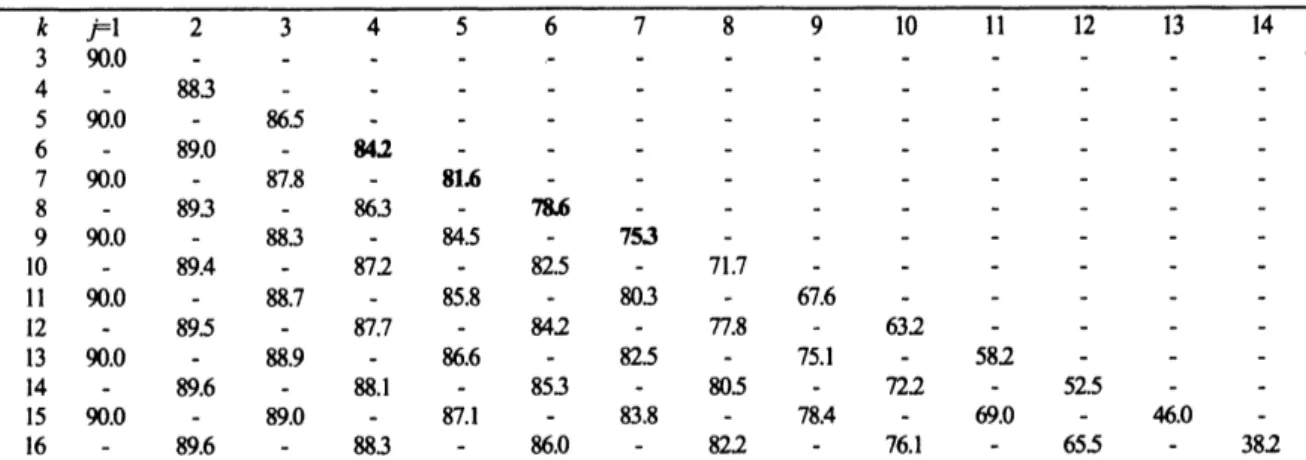ThreeDimensional LargeAmplitudeShallow Water Wave TomoakiHirakawa,MakotoOkamura
InterdisciplinaryGraduate School ofEngineeringScience EarthSystemScience Technology
KyushuUniversity
1.
Introduction
Fluidphenomena aroundusoften cannot beseen.Waterwaves arephenomenathat commonlyand clearlyseen inourordinarylife. And suchwaterwavemotion isanattractivesubjectoffluiddynamics.Thoroughumde1standing ofthe phenomenonisnotsimple andmanyworkshave beendoneonwaterwave.
Above all, three-dimensional interactions of solitary
waves
have been actively studied for the last several decades. Although KoIteweg-de Vries $(KdV)$equation has been known for solitary waves, intemtions ofsolitarywaves
attracted muchattention afteraproposition ofMiles’ theo1y(1981)andaderivation ofapproximatedequationssuch as the Kadomtsev-Petviashvili (KP) equation(1970). Anexperiment of thereflection ofsolitarywavesthat coresponds to theinteractionof
an
incidentwave
andits reflected wavewas
firstconducted by Perroud(1956).$A$vertlcalreflecting wall
was
obliquelysetinawatertank,sothatan
incidentwave
traingenerated along the tankcanhit the reflectingwallatanangle andinteract withitsownreflectedwave. Hefoumdoutthatwhenanincidentwave rmpingesonthereflectingwall,the incidentand the 1eflectedwavesstronglyinteracteachother and thewaveform of theinteracnng region resembles Mach reflection thatwasknownasaphenomenon of compressibleshockwaves. Although the accuracy of the experimentwas
not high because ofa deficient wave generator, measurement insmnents and the small watertank, the realizationofMach reflection in the interaction ofsolitarywaves was
remarkable. After20 years ofthe finding, Miles(1977)theoreticallyinvestigatedreflectionsof solitary
waves
inthe caseofsmallamphtude shallow waterwaves $\epsilon<<1(\epsilon=a_{i}/d$ : $\epsilon=the$nonlinearparameter,$a_{i}=$ theincident
waveamplitude, $d=$ the uniform waterdepth). Heobtainedthesolution forthe oblique inte1action betweentwo solitons and provided an asymptotic description ofthe diffiactionofa soliton at the $\infty mer$ ofinteraction angle $-\sqrt{3\epsilon}<\psi<\sqrt{3\epsilon}$.Hepredicted that themaximum mnupofan incident wavebecomesfourtimeshigher than the
incidentwave amplitude. Tanaka’s numerical 1esultfor $\epsilon=0.3$ shows betteragreement withthe prediction for
non-g1azing reflection than theprediction for strong resonantinteraction. Stationarystateswerealsonotattainedwhen it
was
closeto $\psi=\sqrt{3\epsilon}$.Recently, Yeh,Li&Kodama(2010)havemodified theinteractionpa1ameterusedinMiles’ theory. This modification affects
some
$res\Lambda ts$ when the intemtion angle becomes relatively large. Using a newmodified interactionparameter, the $Ies\iota Ut$proposed byTanaka agrees with that ofMiles’ $ffi\infty Iy$for non-g1azing
reflection better than that of theresonantinteractionmodel. Li,Yeh&Kodama(2011)conducted experimentsfor reflection ofan obliquely incident solitary wave at a veltical wall in the laboratory wave tank in the
cases
of $\in=0.076-0.367$ with $\psi=30^{o}$ and $20^{o}$. This laboratory experiment presents results suppoting Miles’theoretical predictions,aswellasgood agreementwithTanaka’s numerical result
Inthisstudy,weextendweakly nonlinearinteractionsofshallowwaterwavesto strongnonlinear
cases
witha numericalscheme,suchasthe Newtonmethodand theGaleIkmmethod,and calculateperiodicsteadystatesolutions. Awavebecomesasolitarywaveinshallow water thatisnotperiodic.Becausesucha nonperiodicwave isdifficultto beformed withperiodic functions,wedecideparametersso
thata waveforms flat surface between adjacentwave crests. When the nonlinear parameter $\epsilon$ issmall,mostofour results well reproduce Miles’theo1y.However,inratherstrong nonlinearity
cases
of$\epsilon>0.1$,our
oesMts do not agreewell with Miles’ theo1y because the nonlinearityparameter $\epsilon$ in this studyisoutofMiles’approximation ofweakdy nonlinearity $\epsilon$ く$<$ $1.$This tendencyisnatural and
already$repoIt\propto 1$by otherresearchers.
2.
Formulation of the problem
2.1
Fundamentalequationforwaterwaves
We consider fiee surface gravity
waves
on an inviscid, incompressible fluid of uniform depth and also$i_{IT}$otationdflowis assuned. $d$ is anuniform depth, $\phi$ is velocitypotential, $z=\eta(x,y, t)$ issurface displacement, $\chi,$$y$ arehonzontal coordinates and $z$ isve1tical coordinate. Fumdamental equations forwaterwaves arewrittenas
follows
$\phi_{t}+\frac{1}{2}\nabla\phi\cdot\nabla\phi+gz=0$
on $z=\eta(x, y, t)$ (22)
$\frac{D}{Dt}(\frac{P}{\rho})=(\frac{\partial}{\partial r}+\nabla\phi\cdot\nabla)[\phi_{t}+\frac{1}{2}\nabla\phi\cdot\nabla\phi+gz]=0$ on $z=\eta(x,y, t)$
(2.3)
$\phi_{Z}=0$ as $z=-d$ (2.4)
where $g$ isthegravitationalacceleration. Equation(2.3)is aLagrangederivative ofBemoulli’s equation(22).In
stead ofequation(2.3),equationof Lagrangederivativeofafimction$F(x,y,z, t)=z-\eta(x,y, t)=0$ onthe free surface $z=\eta(x,y, t)$ canbe used for the boundary condition:
$\frac{DF}{Dt}=(\frac{\partial}{\partial t}+\nabla\phi\cdot\nabla)F=0$
on
$z=\eta(x,y, t)$ (2.5)
However,thisequationincludesthe fiee surface displacement $\eta(x,y, t)$ as an
unknow1L
forthis reason, wemustreduce$\eta by\propto|$uation($22)$.Inthispoint because equation(2.3)isa$f_{0I}m$aheady
$\eta$ isreduced,(2.3)isuseful.
2.2
Formulation for$numeI^{\cdot}$ical calculationWenornalize vanablesasfollows.
$(x^{*},y^{*},z^{*}, H^{*})=(Kx, Ky, Kz, KH)$, $t^{*}=\omega t,$ $\Phi^{*}=\frac{K^{2}}{\omega}\phi,$ $G= \frac{K}{\omega^{2}}g$, (2.5)
where $K$ is awavenumber, $\omega$ is afrequency ofan incidentwaterwave.
Inordertocalculateasteadyprogressive wave,
we
considermovingcoordinate,$T=px^{*}-t^{*}, Y=qy^{*}, Z=z^{*}$
, (2.6)Here, $p=\sin\theta,$ $q=\cos\theta$. Whena wavenumbervectorofsolitarywave $(k_{\chi/}k_{y})$,wehave lelations:
$k_{x}=K\sin\theta,$ $k_{y}=K\cos\theta$, tane $=k_{x}/k_{y},$
Interactions pattem for solitary waves in$T$ and $Y$-axis canbe treated as periodof$2\pi$. Use equation (2.6) and
substitute
as
$\Phi(Y, Z, T)=\Phi^{*}(x^{*},y^{*},z^{*}, H^{*}) , H(Y, T)=H(x^{*},y^{*}, t^{*})$,
Using derived nondimensionalvariables,wechange the form ofthefundamentalequation for waterwaves asfollows.
$p^{2}\Phi_{TT}+q^{2}\Phi_{YY}+\Phi_{ZZ}=0$ for $Z\leq H(Y, T)$, (2.7)
$P(Y_{t}Z_{r}T)=- \Phi_{T}+\frac{1}{2}(p^{2}\Phi_{T}^{2}+q^{2}\Phi_{Y}^{2}+\Phi_{Z}^{2})+GZ=0$ (2.8) on $Z=H(Y, T)$, $Q(Y,Z, T)=\Phi_{TT}+p^{2}\Phi_{T}(-2\Phi_{TT}+p^{2}\Phi_{T}\Phi_{TT}+q^{2}\Phi_{Y}\Phi_{YT}+\Phi_{Z}\Phi_{ZT})$ $+q^{2}\Phi_{Y}(-2\Phi_{YT}+p^{2}\Phi_{T}\Phi_{YT}+q^{2}\Phi_{Y}\Phi_{YY}+\Phi_{Z}\Phi_{YZ})$ $+\Phi_{Z}(-2\Phi_{ZT}+p^{2}\Phi_{T}\Phi_{ZT}+q^{2}\Phi_{Y}\Phi_{YZ}+\Phi_{Z}\Phi_{ZZ}+G)=0$ on $Z$ (2.9) $=H(Y, T)$, $\Phi_{Z}=0$ on $Z=-d$, (2.10)
Weintroducethewavesteepness
$WS= \frac{1}{2}[H(0,0)-H(\pi, O)]$ (2.11)
whichis halfofthe difference between the peak$H(0,0)$ andthetrough $H(\pi, 0)$.
Assumingthevelocitypotential $\Phi$
as
periodic$\Phi(Y,Z, T)=\sum_{k=0}^{N}\sum_{j=1}^{N}X(Z)\cos(kY)$sinCT), (2.12)
andwe have atruncatedseriesasfollows:
$\Phi(Y_{\fbox{Error::0x0000}}Z,T)=\sum_{k\not\subset 0}^{N}\sum_{j=1}^{N}A_{k_{j}’}[\cosh(\alpha_{kj}Z)+\sinh(a_{kj}Z)\tanh(a_{kj}d)]\cos(kY)\sin(jT)$,
(2.13)
$\alpha_{kj}=\sqrt{p^{2}j^{2}+q^{2}k^{2}}.$
3.
Numerical scheme
At firs,wenumerically calculate the freesurfacedisplacement by applying Newton’s methodtothe dynanuc boundary$\infty$ndition(2.8).The recurrent
$H_{n+1}=H_{n}- \frac{dZ}{dP(Y,H_{n\prime}T)}P(Y, H_{n}, T)$, (3.1)
Next
we useGalerkm’smethod toobtain theindependent relationsforunknowns$A_{kj}$:$F_{lm}(A_{lm/}G)= \int_{0}^{\pi}dY\int_{0}^{\pi}dTQ(Y, H(\mathcal{A}_{lm}, G), T)\cos(lY)\sin(mT)=0$, (3.2)
(3.2)can$k$conside1edas$M$-point Fourier transfonn.Because when $l+m$ isodd,(3.2)ist1ivial,the numberof
independent 1elatlons(32)is $M(M+1)/2$.Anotherindependentrelationisexpressedas
$W(A_{kj}, G)=2WS-[H(0,0,\cdot \mathcal{A}_{kj}, G)-H(\pi, 0,\cdot \mathcal{A}_{kj}, G)]=0$, (33)
whichisa different expression ofthewavesteepness(2.11).Finally,we canobtainasufficient numberofindependent relations andwe
can
solve the nonlinear equations(3.2)and(3.3).Here,the third orderapproximationforshort-crestedwave
calculatedby Hsu$et$. al. (1979)isusedas
the imtial solution ofiteration.We stoptheiterationifthe differencebetween unknowns beforeandafter iterationis smaller than $10^{-10}$. The numberofexpansion terms ofa solution
$N(N+1)/2$ isset
as
$N=30$.The samplingpointforfflerkin’s method(two-dimensional$Fo\iota mer$transform)issetas $2^{}.$
4.
Result
We calculated numerical solutions for various incident amplitudes, depths $d$ and angles of
incidentwaves $\theta$
bychanging initialconditions suchas
wave
steepness $WS$,an
initialdepths andangles of wavecomponents $\theta_{i}$.Notethatwavecomponentswithanangle of $\theta_{i}$ not alwaysforman
incident wavewith the
same
angle and wecan
evaluate the angle ofan incidentwave
only from resulting waveforms. Anincident waveamplitudeisalsoevaluated from aresultas;$a_{i}=H (\begin{array}{ll}\pi \pi\overline{2}^{1}\overline{2} \end{array})-H(\frac{\pi}{2}\prime 0)$ , (4.1)
because ofthesymmetriccondition.Andwedefine the $a_{M}$
as
thecenteroftheinteracting regionofwave profleas;$a_{M}=H(0,0)-H( \frac{\pi}{2},0)$, (42)
that is the same
as
the definition ofwave steepness. Therefore, we define the ratio $a$ ofthe 1naximum waveamplitude toanincidentwaveamplitude as;
$\alpha=\frac{a_{M}}{a_{i}}=\frac{H(0,0)-H(\frac{\pi}{2}\prime 0)}{H(\frac{\pi}{2}J\frac{\pi}{2})-H(\frac{\pi}{2}\prime 0)}=\frac{WS}{H(\frac{\pi}{2}\prime\frac{\pi}{2})-H(\frac{\pi}{2}\prime 0)}$, (4.3)
4.1
Weakly nonlinearcases
In this section, we discuss weakly nonlinear
interactions.
Asymptotic solutions of weakly nonlinear interactions are described by Miles’ theory. 4.1, 4.2 and 4.3 show comparisonsbetween Miles’ theory and numerical results in cases of $d=0.050,$ $d=0.070$ and $d=0.090$ and thedependence of$\alpha$ respectto $\theta_{i}$. Because ofoursymmetric assumption ofasolution,a solution
can
notbe found for $\kappa<1.$
(a) (b)
$\alpha$
0.9 1 1.11.21.3141.51.61.7 85 80 75 70 65
$\kappa \theta_{i}$
Mostofourresults
are
well 1eproduced by Miles’ theory.However,somelarge and smalldiscrepanciesexisted. We will studyonthiscause
furthermo1eandcompareit withharmonicresonanceconditions Figure42showswave a profile andacontour for $\kappa=1.0$ and depths $d=0.050.$$4010_{3}^{\fbox{Error::0x0000}}4510_{2}5010_{3}^{-\urcorner}$ 4
.
$510_{\gamma}$ 3 $H_{2010_{3}^{3}}^{3010}2510^{-3}$ $-\fbox{Error::0x0000}$ 2 $\sim 50105010^{4}1010^{-3}15\cdot 100010_{4}^{0}$ $\angle_{\wedge}\prime\prime----ノ I\prime;\prime\fbox{Error::0x0000}\fbox{Error::0x0000}・\}\prime 蓚$ $–arrow\fbox{Error::0x0000}||s/\backslash \backslash \backslash$$-2-101Y$
$-4-3$
$-0.5$ $0$ 0.5
$T$
$\epsilon=0.0256, \theta=74.99$
FIGURE4.2. Waveprofiles andcontoursfor $\kappa=1.0$ and depths(a) $d=0.050$
When $\kappa=1.0$,
interactions
oftwo solitarywaves are strongand aninteractionregion extendin $Y$direction. Aninteraction of two solitarywaves isthesame phenomena as reflectionofanincident solitarywave sothat Figure 4.2impliesastemextendsinperpendicular tothereflectingwall.
4.2
Harmonicresonance
In many conditions, unexpected rough waves and bad convergence appear. They
seem
sporadic and unavoidableproblems.Mostofinteractingwaveprofilesthatdonotagree with that ofMiles’theory,are
contaminatedby smallerwavecomponents. Those
contaminations occur
sporadically andmake it difficultforsolutionsto converge smoothly.In order to investigated those deviations we sought regions enclosed with black frames (a) and
(b) in Figure 4.3 which is in the case of fixed water depth $d=0.050$ and $0.025<\epsilon<0.050.$
Figure4.4showsenlarged figuresofblackframes(o)and(b)inFigure4.3.
$\alpha$
$80 75 70 65$
$\theta_{i}$
(a)
$\alpha$
76.8 76.6 76.4 76.2 76 75.8 70.6 70.4 70.2 70 69.8 69.6 69.4
$\theta_{i} \theta_{i}$
FIGURF 44.Theratio $a=a_{M}/a_{i}$ versusthewavecomponentsangle$\theta_{i}$ (indegrees),when$d=0.050.(a)$and(b)are
enlarged figures offiames(a), (b)in FIGURE4.3
Figure 4.4showsweobtained solutionsin pairs inmostofwave$\infty$mponentsangles $\theta_{i}$.At
ffist
wechecked(b-3)
$45\cdot 10_{-3}^{-3}40\cdot 10_{3}35\cdot 10_{\sim 3}^{\vee^{\wedge}}$
30
$2510_{3\fbox{Error::0x0000}}$
$H_{1510_{3}^{-3}}^{20\cdot 10}$
10
$-50.10_{-3}・50.\cdot 10001Q_{4}^{0}$
FlGuRE4.5. The waveprofile of$(a);d=0.050,$$\theta_{i}=76.8,(b);d=0.05,$ $\theta_{i}=75.8,$
$(c);d=0.09, \theta_{i}=71.6,(d);d=0.09, \theta_{i}=70.8.$
Inthenextplace,wecheck absolute values ofdifferences betweeneachmodes $|\delta A_{kj_{i}\theta_{i}}|$ ofthosepairs;$(a-1)-$ (a-2),$(a-3)-(aA),$ $(b-1)-(b-2)$and$(b-3)-(bA)$in Figure 4.5. $\delta A_{kj,\theta_{i}}$ isdefinedas;
$\theta_{i}=70.60^{o}$ $|\delta A_{kj,\theta_{i}}|$ $2010^{4}31560|0^{4}478.00(000|1||1|0^{4}0^{4}0^{4}0^{-4}0^{4}0^{4}|_{f}-$ $c_{5arrow}$ $j$ TO $arrow c/_{0}’$
FIGURE46.The absoluevalueofa diffenencecoefficient $|A_{kj,\theta_{i}}|$ fiom $(k,j)=(0,1)$to $(k,j)=(12,13)$
(i)
$\theta_{j}=75.90^{o}$(ii)
$\theta_{i}=76.20^{o}$(iii)
$\theta_{i}=76.50^{o}$(iv)
$\theta_{i}=76.79^{o}$FIGURE4.7.Theabsolute value ofadffienenoe coefficient $|A_{kj,\theta_{t}}|$ from $(k,j)=(0_{z}1)$ to $(k_{\Delta}j)=$ $(12,13)$:
(i)
$\theta_{i}=69.40^{o}$(ii)
$\theta_{i}=69.80^{o}$(iii)
$\theta_{i}=70.20^{o}$(iv)
$\theta_{i}=70.59^{o}$FIGURE4.8. The absolute value ofa diffenence coefficient $|A_{kj,\theta_{i}}|$ fiom $(k,j)=(0,1)$to $(k,j)=$ $(12,13)$:
(1) $\theta_{i}=69.40^{o}$, (ii)$\theta_{i}=69.80^{o}$,(iii) $\theta_{i}=70.20^{o}$, (iv) $\theta_{i}=70.59^{O}.$
(a) (b)
76.8 76.6 76.4 76.2 76 75.8 70.6 70.4 70.2 70 69.8 69.6 69.4
$\theta_{j} \theta_{i}$
FIGURE4.9.The value ofadiffenence coefficient $A_{kj,\theta_{i}}.$$(a)$,(b)coresspondtoenlargedfigure of frames(a),(b)
in FIGURE4.3.
We make it clear weather those rough waves instabihties
are
occurred by an effect of a harmonicresonance
or not. The harmonicresonance
ofthreedimensional interactions of water waves for finite depth and weakly nonlinearitycases
is known to exist (Ioualalen 1996) ifinteractions
ofwavessatisfy$a_{kj}\tanh(\alpha_{kj}d)=j^{2}tanh(d)$ (4.6)
where solutions form
are
written as$\Phi(Y,Z,T)=\sum_{k=0}^{N}\sum_{j=1}^{N}A_{kj}[\cosh(a_{kj}Z)+\sinh(\alpha_{kj}Z)\tanh(\alpha_{kj}d)]\cos(kY)\sin 0T)$, $\alpha_{kj}=\sqrt{p^{Z}j^{2}+q^{2}k^{2}}$
Because equation (4.6) is only dependent on $d,$ $k,$$j$ and $\theta$, when water depth $d$ is given, we can
makea tablethatshows harmonic
resonance
angle $\theta_{HR}$.TABLE4.1showsharmonicresonance
angles $\theta_{HR}$ when $d=0.050$$k$ $\Gamma^{-1}$ 2 3 4 5 6 7 8 9 IO 11 12 13 14 3 $\Re).0$ 4 883 5 $\mathfrak{A})0-$ 86.5 6 $-$ 890 84.2 7 900 87.8 $81^{-}.6$ 8893 863 $-$ 7&6 9 90.0 883 84.5 $75J$ IO 894 872 82.5 717 II $\mathfrak{A}J.0$ 88.$7$ 858 80.$3$ 676 I2 895 87.7 842 77.8 $63^{-}2$ 13 $(X).0$ 889 86.$6$ 82.$5$ 75.$1$ 582 I4 - 89.6 88.$1$ 853 80.$5$ 722 $52^{-}.5$ 15 $\Re]0$ 890 87.$1$ 838 784 69.$0$ 46.$0$ $-$ $16$ $89^{-}.6$ 88.$3$ $-$ 86.$0$ 822 76.$1$ $-$ 655 382
TABLE4.1.Harmomcresonanceangles $\theta_{HR}$ (indegrees)when$d=0.050$.Harmonicresonanceangles $\theta_{HR}$
when $(k,j)=(6,4)$,$(7_{\fbox{Error::0x0000}}5)$,$(8,6)$ and $(9,7)$ arewritten$m$bold
We couldn’t find good agreement between hamlonic resonance angles $\theta_{HR}$ and the angle where those
discrepancies occur. Harmonicresonanceangles $\theta_{HR}$ when $(k,j)=(6,4)$,$(7,5)$,$(8,6)$ and$(9,7)$ are84.2, 81.6,78.6
and753.Accordingly, angles of frames(a)and(b)inFigure4.3werenoagreement wth hannonicresonanceangles.Because
harmonicresonanceanglesarebasedonlinear theory,$nonlineaI\rceil ty$might have effectedonthose angles.
4.3
Strong nonlinearcases
In this section, we discuss rather strong nonlinearinteractions. In thecase ofrather large $\epsilon,$
results
are
unstable and solutions become more difficult to converge thanweakly nonlinearcases. Bad convergences sporadically occur with changing conditions and often result in rough wave interactionprol][les.Followingfigures shownumerical resultscorresponding to $\epsilon=0.2$,0.3.(X
$\kappa$
FIGURE4.10.Thetatio $a=a_{M}/a_{i}$ versustheinteraction parameter $\kappa$ when$\epsilon=0.20.$
$\alpha$
$\kappa$
In the
case
of rather large $\epsilon$, numerical results do not agree with Miles’ theory becausenonlinearityparameter $\epsilon$ isoutofMiles’approximation of weakly nonlinearity $\epsilon<<1.$
Figure 4.10 and 4.11 differs depending on water depths $d$. However, even if the depth $d$ is
different,results should show thesameresult when $\epsilon$ arethesamebecause theratio $d/2\pi$ ofthe
depth $d$ tothe wavelength $2\pi$,which associatedwithsolitaryofwaves,isset sufficientlysmallto be
assumed the wavelength
as
infinity forwaves in
an
cases,sucha
smallchangein
depths $d$ shouldnotaffect to thesolutions.
For
various
conditions excluding the criticalcases
around $\kappa=1$ and Mach reflection region$\kappa>1$, there
are cases
thatresults shows rough waves or become unstable and do not convergeenoughwhichpreventedustoobtainfavorabledata in succession. Those deviations arelarger than those
occur
inweaklynonlinearcases.
$H$ $-15$ $-1$ $-05$ $0T$ 05 1 15 (o) 012 01 $0$os 006 $H$ 0.04 002 $0$ 002 $-15 -1 -05 0_{T}05 I 15$ (b)
FIGURE4.12. Wave profilesandcontou1sfor$\kappa=1.0$ and depths(a)$\epsilon=0.2$ and(b) $\epsilon=0.3.$
5. Conclusion
The scheme used in this 1esearch
was
successful to obtain solutions forthree limensional large amplitude shallowwaterwaveof$\epsilon$ upto0.5.When $\in$ issmall,mostofournumericalresults show good agreement withMiles’theory.However,
some
discrepanciesexistand we observedwave
profilesbecame rough anddifficultto convergence in those cases. They occur sporadically and we couldn’t avoid such rough waves of solutions by reducingstepsin calculations ofthe Newton method. Andas$\epsilon$ increases, starts decreasingand differencesbetween thenumerical results and Miles’ theory increaseand resulting waveprofiles tend to be contaminatedwhen $\kappa$ is closeto1.
Existence of hannonic
resonances
has been knownforperiodic solutions ofweakdy nonlinear shallowwaterwaves.
Because thesolutionsusedinthis studyare
periodic, the solutionsaso
havepossibility toshowharmonicresonances.
Angles of fiames(a)and(b)inFiguIe4.3werenoagreement with hartnonicresonanceangles. BecauseharmonicReference
[1]
Ablowitz
MJ.&Baldwin,
DE.,2012.Nonhnear shffiowocean
wavesolitoninteractionson
flat beaches.[2] Concus, P., 1962. Standing capillary gravitywavesoffiniteamplitude.Journal
ofFluid
Mechanics,pp.568-576.
[3] Fultz,D., 1962.Anexperimental noteonfinite-amphtudestandinggravity
waves.
Joumaloffluid
mechanics.Funakoshi, M.,1980.ReflectionofObliquely Incident SolitaryWaves.pdf
[4] Hammack, J.,1989. Two-dimensional periodic
waves
in shallowwater.Joumal ofFluidMechmics, Hammack,J.,1995.Two-dimensional periodic
waves
inshallow water. Part2. Asymmetricwaves.
JFluidMech,285.[5] Hsu, J.,1979. Third-orderapproximationtoshort-crested
waves.
JoumalofFluidMechanics
[6] Ioualalen,M.&Kharif,C.,1993.Stabilityofth1eedimensional p1ogressive$\Psi^{vity}$
waves
ondeepwaoer
tosupe1harmonicdisturbances.Eur. J. Mech. B.FluidS,pp. 401-414.
[7] Ioualalen,M.,Roberts,
a
J.&Kharif,C., 1996.Onthe observabihty offinite-depth short-crestedwaterwaves.
JournalofFluidMechanics, 322,pp. 1-19.
[8] Ioualalen, M. & Kharlf, C., 2006. On the subharmonic instabilities ofsteady three-dimensional deep water waves.Journal ofFluidMechanics,$262(-1)$,p.265.
[9] Kadomtsev,B.B.&Petviashvili,V.I.,1970. Onthestability ofsoliffiywavesin weakdy dispersive media. Sov.
Phys. Doklady, 15,pp.539-541.
[10] KnickerbockerNewel,1985.Reflectionsfiomsolitarywavesinchannels ofdec.
[11] Kodama, Y., Oikawa,M. &Tsuji,H.,2009. Soliton solutionsofthe KPequationwith$V$-shapeinitialwaves.
JournalofPhysics A:$Mathemat\iota cd$and
Theoretical
42(31),p.312001.[12] Laitone, E.V, 1962.Limiting ConditionsforCnoidalandStokesWaves.JournalofGeophysicalResearch,67(4),
pp.1555-1564.
[13] Li,W.,Yeh, H.&
Kodama.
Y.,2011. Onthe Mach reflectionofasolitarywave:
1evisited.JournalofFluid
Mechanics, 672,pp.326-357.[14] Miles, J.W.,1977. Noteon asolitarywave.Journal ofFluidMechanics,pp. 149-152.
[15] Miles, J.W.,1977aObliquelyinteracting solitarywaves.JournalofFluidMechanics,79.
[16] Miles, J.W.,1977b.OnHamilton’sprinciple forsurfhcewaves.Journal ofFluidMechanics,83(01),p. 153.
[17] Miles, J.W.,1977c.Resonantlyinteracting solitary
waves.
JoumalofFluidMechanics, 79,pp.171-179.[18] Miles, J.W., 1981. The KortewegdeVries equation: a historical essay.Journal
ofFluid
Mechanics, $106(-1),$p.131.
[19] Okamum$*$M.,2010. Almostlimitingshort-crested gravitywavesindeepwater.Journal
ofFluid
Mechanics,646,p.481.
[20] Tanaka, M., 1993. Mach reflection ofa large-amplitude solitary
wave.
Journalof
FluidMeckmcs, 248,pp.637-661.
[21] Tanaka,M.,1986.Thestability ofsolitarywaves.Phys.Fluids.
[22] Tsai,C.-P.&Jeng,D.-S.,
1994.
Numerical Foumier solutions ofstandingwaves
in finitewaterdepth.[23] Wineberg,S.
&McGrath
J., 1991. Implicitspectral methodsforwavepropagation problems.JournalofFluid
Mechanws,336.
[24] Yeh, H.,Li, W.&Kodama,Y.,2010.Machreflectionand KPsolitonsin shallowwater.,p.16.
InterdisciplinaryGraduate SchoolofEngineering Science Kyushu
University
6-1 Kasuga-Koen, Kasuga
816-8580
Japan






